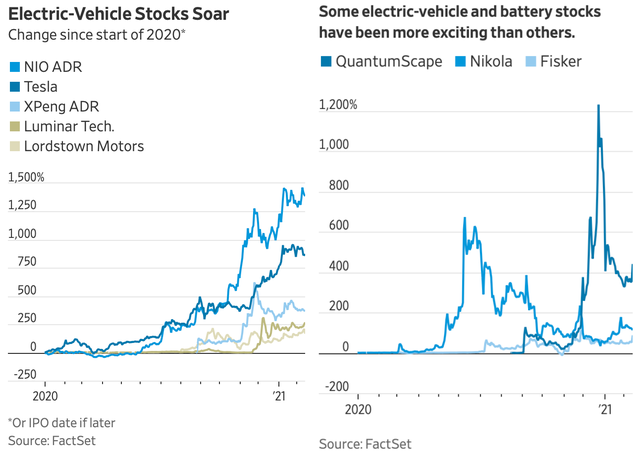What if the ‘bubble Tesla’ bursts?
- Tram Ho
The recent “craze” of electric vehicle stocks, clean energy or even stimulants is certainly a threat to the assets of their shareholders. But even if there was one inflated bubble, the disaster wouldn’t affect the entire market.
Developments over the past few decades have shown just the opposite. Japan is still affected by the real estate and stock bubble of the 1980s, or the dot-com bubble that caused heavy losses and subprime debt sparked a global crisis.
However, not all bubbles are the same. The dangers of the stock bubble come from borrowers who borrow to buy stocks and over-invested companies. When the bubble burst, these investors were forced to cut spending or even go bankrupt. Companies unexpectedly faced investor requests for layoffs and investment cuts.
None of the above is a clear problem for recent favorites. Tesla is valued at an extremely high level and becomes the fifth largest company by market capitalization in the United States. Even if the company disappears tomorrow, it won’t have a significant impact on the economy, as Tesla’s size of operations is still very small.
The reason is because the electric car maker is mostly financed by their own capital, so the collapse won’t cause a domino disaster for the banks. While shareholders will incur significant losses, the spending of people across the United States will not be reduced by this event.

Shares of electric vehicle manufacturers and related companies both soared thanks to the Tesla “fever”.
The most recent similarity event was not the dot-com bubble, but the UK cycling craze of the 1890s. Bicycles were electric cars at that time. The breakthrough in tire technology has turned bicycles into a convenient and eco-friendly means of transport, albeit at a high price.
Investors have flocked to the shares of any company with a connection to the bicycle industry, mainly in Birmingham. Strong investments have created other breakthroughs. At its peak, bicycle-related patents accounted for 15% of the total number of patents granted.
Bicycle shares were also driven by extremely low UK interest rates. Accordingly, smaller bubbles are also inflated, eg Australian breweries and breweries.
The content of the book “Boom and Bust” by William Quinn and John Turner – two scholars of Queen’s University, said that in 1896, the country had 671 bicycle companies and raised 27 million pounds, equivalent to 1.6% of GDP. Comparing the similarities, the SPACs raised capital equivalent to about 0.4% of US GDP last year and are “accelerating” at 1.3% year-to-date.
Half of the market-listed bicycle makers fail by the end of the decade. Speculators still holding shares when the bubble bursts was “engulfed” by a 71% drop from the peak in just 18 months. Accordingly, the regional economy is affected when the market collapses. However, the UK was generally unaffected and neither was the rest of the market.

If apart from Tesla, the Big Tech – including Apple, Amazon, Microsoft and Facebook, was also a bubble, investors would surely lose a lot of money. However, with a few exceptions, these companies do not borrow or issue new shares to raise capital for new investments and their investors do not borrow too much. If Apple’s stock price halved, its underlying business wouldn’t be affected. This is different from dot-com, as companies back then were forced to cut spending when the market crashed and they couldn’t issue new shares.
” The lesson from what has happened in history is that the stock market crash did not cause that much damage. The bubble that was ‘financed’ by the new banks” is really the kind of bubble that has, ”said William Quinn . destructive power . ”
The Black Monday event of 1987 was another example: it affected investors but the economy was unaffected. However, this doesn’t mean that everything will be fine. Unlike previous events, the Fed could not support the market so easily. After the market fell for more than 6 months because of the dot-com bubble event, the Fed quickly lowered interest rates from 6.5% to 1.75% and finally 1%, helping to protect the economy from a slump. of the market.
Currently, public debt is at an exceptionally high level. Companies with weak finances have had to borrow to survive when the economy closed due to the pandemic, while larger firms have borrowed to buy treasury shares. Lower interest rates mean cheaper debt, but if the market loses confidence, refinancing may be more difficult. A sharp decline in the stock market can affect the economy when people feel they are poorer and begin to cut down on spending.
Refer to the Wall Street Journal
Source : Genk
